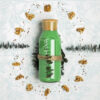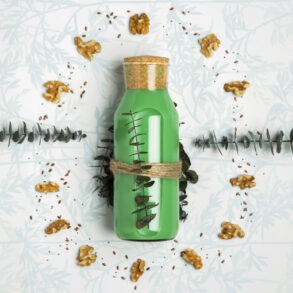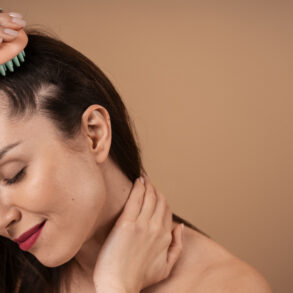Introduction to Carbuncle
What is a Carbuncle?
A carbuncle is more than just an annoying bump—it’s a painful, deep skin infection made up of interconnected boils (furuncles) that form a cluster of pus-filled lumps beneath the skin. Unlike a single boil that’s isolated and manageable, a carbuncle can spread, swell, and even rupture, releasing pus. Gross? Yes, but your body’s response to this kind of infection is no joke.
Carbuncles typically form when Staphylococcus aureus, a bacterium commonly found on the skin, enters hair follicles or small cuts. Once inside, it sets off an immune system alarm. The result? A red, swollen, inflamed area that hurts like crazy. Over time, the center may turn yellow or white due to the accumulation of pus. What sets it apart is the cluster effect—multiple boils fusing into one monster.
This skin menace can develop anywhere but loves the neck, back, shoulders, or thighs. These are places where friction, sweat, and poor hygiene can allow bacteria to thrive.
Beyond the physical discomfort, a carbuncle can disrupt daily life, affecting sleep, self-confidence, and even mobility if it’s located near joints. And while it’s often treatable at home in mild cases, some carbuncles require medical intervention, especially if they’re deep, spreading, or recur frequently.
Difference Between Carbuncle and Boil
Let’s be real: most people mix up carbuncles and boils, and on the surface, they do look similar. Both are skin infections filled with pus, but the key differences are in size, pain level, and severity.
| Feature | Boil (Furuncle) | Carbuncle |
|---|---|---|
| Definition | Single infected hair follicle | Cluster of interconnected boils |
| Size | Usually small | Larger and deeper |
| Pain Level | Moderate | Intense |
| Pus Drainage | From one center | Multiple drainage points |
| Contagious | Less likely | More likely |
| Treatment | Often home-treatable | May require antibiotics or surgery |
| Healing Time | Few days | 1–3 weeks |
Boils usually don’t need medical help. A warm compress and time can often clear it up. Carbuncles, however, are the boss level of boils—they demand more attention. They can cause fever, fatigue, and even spread the infection to your bloodstream if ignored.
Who Is at Risk?
Carbuncles don’t discriminate, but some folks roll the dice more often than others. Understanding your risk can help you prevent future flare-ups.
Top risk factors include:
- Poor hygiene: Not washing regularly or sharing personal items increases exposure.
- Weakened immune system: Conditions like diabetes, HIV, or undergoing chemotherapy.
- Chronic skin conditions: Eczema or acne can create skin breaks.
- Close contact environments: Think dorms, prisons, or gyms—places where bacteria love to party.
- Age: Middle-aged and older adults tend to get carbuncles more often.
- Obesity: Extra skin folds create breeding grounds for bacteria.
- Previous carbuncles or boils: Once you get one, you’re more likely to get another.
Genetics can also play a small role—some families just seem to have more trouble with these infections. And men, unfortunately, get them more often than women, possibly due to denser hair follicles.
Causes of Carbuncles
Bacterial Infections and Their Role
At the heart of every carbuncle is an unwelcome visitor: Staphylococcus aureus. This bacterium, although normally harmless on our skin, becomes a menace when it invades through a cut, scrape, or hair follicle.
But why does it cause such a mess? Staph bacteria are like the hackers of the skin world. They sneak in, take over the immune system’s local defenses, and trigger massive inflammation. Once inside, they release toxins that kill cells, creating a pocket of pus—a mix of bacteria, white blood cells, and dead tissue. When this process happens in several follicles close together, you get a carbuncle.
Certain strains of S. aureus are more aggressive, especially MRSA (Methicillin-Resistant Staphylococcus aureus), which is resistant to common antibiotics. MRSA-related carbuncles are harder to treat and more dangerous.
Contributing Factors
Carbuncles don’t just appear out of nowhere. Multiple internal and external factors set the stage:
- Skin trauma: Even minor cuts or shaving nicks can allow bacteria in.
- Sweating and friction: Tight clothing or excessive sweating promotes bacterial growth.
- Poor nutrition: A weak immune system from bad diet = easy target.
- Dehydration: Dry skin cracks more easily, giving bacteria an entry point.
- Lack of sleep and stress: Chronic stress weakens immunity.
Interestingly, people with chronic illnesses like diabetes or kidney disease are more prone because their immune responses are less effective. Smoking also reduces blood flow to the skin, delaying healing.
How It Spreads
Carbuncles are not just personal—they can be contagious. Sharing towels, razors, or even bed linens can transfer bacteria from one person to another. If someone in your household has a carbuncle, extra precautions are necessary.
It can also spread within your own body. For example, if you pop a boil or carbuncle improperly, the bacteria can invade nearby tissues or even enter the bloodstream, leading to cellulitis or sepsis.
Common spreading routes include:
- Touching the infected area and then touching another part of your body
- Inadequate wound care
- Reusing contaminated personal items
- Not cleaning hands or surfaces
Symptoms of Carbuncle
Initial Symptoms
It often starts small. A little redness, maybe a tender bump near a hair follicle. But don’t be fooled—it escalates fast. The early warning signs of a carbuncle include:
- Red, raised bump that’s painful to touch
- Skin around it feels warm
- Tight, itchy sensation
As it grows, the center of the lump fills with pus and may develop a white or yellow tip. You might notice a burning or stinging sensation, especially when the area is bumped or touched. Unlike a pimple, though, it goes deeper into the skin and hurts way more.
Progression and Severity
Over a few days, things can get intense. Here’s what you can expect:
- Enlargement: It becomes a cluster of boils rather than a single bump.
- Pus discharge: Multiple heads might ooze pus.
- Fever and chills: Signs the infection is systemic.
- Fatigue: You feel drained even without much activity.
- Swollen lymph nodes: Nearby nodes, like in your neck or groin, may swell.
It can get so severe that moving becomes uncomfortable, especially if the carbuncle is near a joint or high-friction area like the inner thighs.
The skin might also rupture on its own, releasing a significant amount of pus—while that sounds like relief, it’s also a high-risk moment for spreading infection.
When to Seek Medical Help
It’s tempting to tough it out, but some signs mean it’s time to ditch home remedies and call a doctor:
- No improvement after 5–7 days of home treatment
- Carbuncle larger than a golf ball
- Persistent fever or chills
- Red streaks around the infection site
- You have diabetes or a compromised immune system
Ignoring these warning signs can lead to hospitalization or even life-threatening conditions like sepsis. Don’t risk it—better safe than sorry.
Diagnosis of Carbuncles
Physical Examination
Diagnosing a carbuncle usually begins with a thorough physical examination. A doctor will visually inspect the affected area and assess the size, appearance, and severity of the lesion. They might gently press on the carbuncle to determine the amount of pus and tenderness.
Unlike other skin issues like acne or cysts, carbuncles are notably more painful and swollen, often presenting with multiple heads (pus-filled pockets). The physician will ask questions such as:
- When did the lesion first appear?
- Have you experienced similar infections before?
- Are you experiencing fever or fatigue?
- Do you have any underlying health conditions?
The answers help determine whether the carbuncle is isolated or part of a recurring issue that may need deeper investigation.
Carbuncles often occur in predictable locations such as the back of the neck, shoulders, thighs, and buttocks. These areas are prone to sweating and friction, creating ideal conditions for bacterial infection. A clinician can often diagnose a carbuncle on sight, but more tests may be needed for complicated cases.
Lab Tests and Cultures
If your infection is large, keeps coming back, or is accompanied by fever, your doctor might order lab tests. These could include:
- Pus culture: A sample is taken from the carbuncle to identify the type of bacteria causing the infection. This helps determine if MRSA or another resistant strain is involved.
- Blood tests: To check for elevated white blood cells (a sign of systemic infection).
- Blood sugar test: Especially important if diabetes is suspected, as it significantly raises the risk of recurring infections.
Cultures are especially important for antibiotic selection. Not all carbuncles respond to the same medications, and guessing can delay healing and promote resistance. Identifying the exact bug behind the infection leads to faster, more effective treatment.
Differential Diagnosis
Skin infections can mimic other conditions, so doctors may consider alternate diagnoses before settling on a carbuncle. Here are a few examples:
| Condition | Similarity | Key Differences |
|---|---|---|
| Boil (Furuncle) | Similar redness and pus | Single head, smaller, less severe |
| Cyst | Painless bump under skin | Not red, no pus unless infected |
| Hidradenitis Suppurativa | Multiple painful lumps | Chronic and recurring, often without pus |
| Spider bite | Red, swollen, painful | May have two puncture marks |
| Cellulitis | Red, warm, swollen skin | Spreads widely without pus pockets |
Physicians use a combination of history, symptoms, and lab tests to make the right call, ensuring you get the proper treatment.
Treatment Options
Home Remedies
For small carbuncles, home treatment is often enough—especially in the early stages. You can soothe the pain and possibly prevent the infection from worsening using some tried-and-true methods.
Effective home treatments include:
- Warm compresses: Apply a warm, damp cloth to the area for 15–20 minutes, 3–4 times a day. This helps increase blood flow and encourages drainage.
- Antiseptic washes: Use antibacterial soap or iodine-based washes to keep the area clean.
- Turmeric paste: Known for its anti-inflammatory properties, turmeric mixed with water or coconut oil can be applied directly.
- Tea tree oil: Natural antibacterial oil, but it should be diluted and used cautiously to avoid irritation.
- Keep it covered: Use sterile bandages to prevent the spread of bacteria.
But remember—home remedies are only effective for mild infections. If you notice no improvement in a week or the carbuncle worsens, seek professional help immediately.
Over-the-Counter Medications
While OTC meds won’t cure the infection, they can help manage the discomfort and reduce inflammation.
- Pain relievers: Ibuprofen or acetaminophen can ease swelling and pain.
- Topical antibiotics: Neosporin or Bacitracin might help for minor bacterial infections, although they’re less effective once a carbuncle is fully formed.
- Hydrocortisone cream: Useful for relieving itching, but it doesn’t kill bacteria.
These are supportive treatments—not cures. They can buy you time while the body fights off the infection or supplement prescription medications later.
Prescription Treatments
When a carbuncle refuses to shrink or is accompanied by fever, it’s time for prescription intervention.
- Oral antibiotics: Doctors may prescribe clindamycin, doxycycline, or Bactrim (especially for MRSA).
- Topical antibiotics: Mupirocin is often used for stubborn skin infections.
- Retinoids: Occasionally prescribed for recurring skin infections tied to acne or oily skin.
The key with prescriptions is complete the full course. Many people stop taking antibiotics when symptoms improve, which can lead to stronger bacterial resistance and future flare-ups.
Medical Procedures
Incision and Drainage
One of the most effective ways to treat a large or painful carbuncle is through surgical drainage. This in-office procedure is quick, but it’s highly effective.
Here’s what typically happens:
- The area is cleaned and numbed using a local anesthetic.
- A small incision is made to allow the pus to drain out.
- The wound may be packed with gauze to keep it open and facilitate healing.
- A bandage is applied, and aftercare instructions are provided.
This provides immediate relief from pressure and pain. In many cases, once the pus is drained, the body can heal more rapidly. But proper wound care is crucial. You’ll need to change dressings regularly and avoid picking at the site.
Antibiotic Therapy
Post-procedure, doctors often prescribe a course of antibiotics. If the carbuncle was cultured and identified as MRSA or another resistant strain, treatment is adjusted accordingly.
| Antibiotic | Common Use | Notes |
|---|---|---|
| Clindamycin | MRSA and severe infections | May cause GI upset |
| Doxycycline | Effective for skin bacteria | Sun sensitivity possible |
| Trimethoprim-Sulfamethoxazole | Often used for staph | Avoid if allergic to sulfa drugs |
For people with compromised immune systems, a longer or more potent antibiotic course might be needed, sometimes delivered via IV in a hospital setting.
Hospitalization Cases
Though rare, some carbuncles are so severe they require hospitalization. This usually happens when:
- The infection spreads rapidly (cellulitis or sepsis).
- The patient has chronic illnesses like diabetes or HIV.
- The carbuncle is located near vital organs (e.g., on the face).
In these cases, IV antibiotics, surgical drainage under anesthesia, and constant monitoring are necessary. Fortunately, with proper care, most people recover fully within a couple of weeks.
Natural and Herbal Remedies
Popular Natural Treatments
Many people turn to nature before heading to the doctor—and for mild carbuncles, this can be surprisingly effective. The most commonly used remedies include:
- Turmeric: A teaspoon mixed with milk or water, consumed daily or applied as a paste.
- Garlic: Crushed cloves applied to the skin or taken raw due to its antimicrobial properties.
- Neem (Indian Lilac): Used in paste or oil form for its antibacterial and antiseptic benefits.
- Epsom salt baths: Helps draw out toxins and reduce inflammation.
- Aloe vera: Applied to the skin to soothe and heal damaged tissue.
Natural doesn’t always mean better, but for minor or early-stage carbuncles, these can reduce inflammation and support healing.
Effectiveness and Evidence
Scientific studies are limited, but some herbs like turmeric and neem have shown antibacterial effects in lab tests. Still, these remedies should complement—not replace—medical treatment for serious cases.
Pros:
- Fewer side effects
- Easily accessible
- Budget-friendly
Cons:
- Slower results
- Risk of allergic reactions
- Not effective for MRSA or deep infections
Always do a patch test and consult with a healthcare provider before trying something new—especially if you’re already on medication.
Risks and Benefits
Here’s a handy table outlining the advantages and disadvantages of using natural remedies for carbuncles:
| Remedy | Advantages | Disadvantages |
|---|---|---|
| Turmeric | Anti-inflammatory, antibacterial | Can stain skin, may interact with meds |
| Garlic | Natural antibiotic | Strong odor, skin irritation |
| Neem | Kills bacteria, soothes skin | Limited clinical studies |
| Aloe vera | Cooling, healing | May not address infection directly |
| Tea tree oil | Antimicrobial | Must be diluted, can cause dermatitis |
While natural remedies have their place, never rely solely on them if your carbuncle is worsening or causing systemic symptoms.
Complications from Carbuncles
Scarring
One of the most common after-effects of a carbuncle is scarring. Because carbuncles penetrate deep into the skin and often require drainage, they tend to leave noticeable marks once healed. The healing process creates fibrous tissue that replaces the damaged skin, leading to scars that can be raised, discolored, or sunken.
Types of scars resulting from carbuncles:
- Atrophic scars: Sunken or pitted appearance, often due to tissue loss.
- Hypertrophic scars: Raised and thick, but within the boundaries of the original wound.
- Keloids: Raised scars that grow beyond the original area (more common in people with darker skin).
Scars can be emotionally distressing, especially if they occur in visible areas like the face, neck, or hands. Many individuals experience a dip in self-confidence, and in some cases, psychological counseling may be needed to address self-esteem issues.
To minimize scarring:
- Start treatment early
- Avoid squeezing or popping
- Keep the wound clean
- Use scar-reducing creams or silicone sheets after healing
In severe cases, dermatological procedures like laser therapy, microneedling, or steroid injections may be recommended to improve skin appearance.
Spread of Infection
Carbuncles are more than skin deep. If left untreated or handled improperly, the bacteria inside can spread. This local infection can evolve into a more serious condition like cellulitis, where the infection travels to deeper layers of skin, or worse, into the bloodstream.
Signs the infection is spreading:
- Red streaks radiating from the carbuncle
- Swollen lymph nodes
- Uncontrolled fever and chills
- Rapid heart rate or low blood pressure
Once the infection spreads, it can invade bones (osteomyelitis), joints (septic arthritis), or even the brain and heart in extreme cases.
That’s why early intervention and hygiene are essential. What starts as a bump could turn life-threatening if ignored.
Sepsis and Systemic Issues
Sepsis is the body’s extreme reaction to an infection—it’s rare with carbuncles but not impossible, especially in individuals with compromised immune systems or unmanaged diabetes. If bacteria from a carbuncle enter the bloodstream, they can trigger widespread inflammation.
Symptoms of sepsis include:
- Fever or hypothermia
- Rapid breathing or heart rate
- Confusion or disorientation
- Decreased urine output
This is a medical emergency requiring hospitalization, IV antibiotics, and intensive care. If untreated, sepsis can lead to organ failure and death.
To avoid such outcomes, recognize the signs early and treat carbuncles seriously—not as just another pimple.
Prevention Techniques
Hygiene Practices
Good hygiene is your first line of defense against carbuncles. Since these infections often start when bacteria enter through small cuts or clogged hair follicles, keeping your skin clean and protected is essential.
Daily hygiene tips:
- Shower daily, especially after sweating
- Use antibacterial soap in high-risk areas like armpits and groin
- Don’t share personal items like razors, towels, or clothing
- Keep nails trimmed and clean to prevent scratching open wounds
Disinfect frequently touched surfaces, especially if someone in your household has a skin infection. Bedding, doorknobs, and bathroom counters can harbor bacteria.
For those with recurring infections, doctors may recommend nasal decolonization with mupirocin ointment, as Staphylococcus aureus often lives in the nostrils and can spread to the skin.
Lifestyle Changes
Simple adjustments in daily life can go a long way in preventing carbuncles, especially if you’re prone to skin issues.
Key lifestyle habits to adopt:
- Stay hydrated: Dry skin is more prone to cracking, which gives bacteria an entry point.
- Eat a balanced diet: Foods rich in vitamin C, zinc, and protein support skin health and immunity.
- Exercise regularly: Helps improve circulation and boosts immune function.
- Avoid tight clothing: Friction and sweat create perfect conditions for bacterial growth.
- Quit smoking: It impairs circulation and delays healing.
Regular exercise and good sleep patterns help keep your immune system strong, making it easier for your body to ward off infections.
Preventive Medications
If you suffer from recurring carbuncles, doctors may suggest preventive antibiotic regimens or topical treatments to minimize risk.
- Mupirocin (nasal ointment): Reduces staph colonies in the nose
- Chlorhexidine washes: Used during showers to kill bacteria on the skin
- Long-term low-dose antibiotics: Used in rare, severe cases under close medical supervision
However, prevention is always preferable to medication. Strengthening your immune system and maintaining hygiene can often be enough to keep carbuncles at bay.
Living with Carbuncles
Managing Recurrence
Recurring carbuncles are not just frustrating—they’re a sign that something deeper might be going on. Whether it’s poor hygiene, an immune deficiency, or untreated diabetes, addressing the root cause is key.
What you can do:
- Keep a skin care routine that includes regular cleansing
- See a doctor to rule out chronic conditions
- Consider lifestyle counseling or a dietitian if obesity is a contributing factor
- Use antimicrobial cleansers weekly even after the infection clears
- Rotate clothes and change bed linens frequently
Avoid popping or scratching lesions. This spreads bacteria and worsens the condition. Instead, let professionals handle drainage when necessary.
Emotional and Psychological Impact
Let’s be honest—having a carbuncle is no picnic. It hurts, it’s gross, and it can seriously mess with your confidence. People often feel embarrassed or anxious, especially if they get carbuncles in visible areas.
Some even experience body image issues, social withdrawal, or depression. It’s more than skin-deep—it’s mental too.
Here’s how to cope:
- Talk to someone: A counselor, therapist, or support group can help
- Educate yourself: Knowing it’s a common issue can reduce shame
- Self-care: Keep up your grooming and hygiene even during flare-ups
Remember, you’re not alone, and it’s not a reflection of poor character or cleanliness.
Support and Care Tips
For caregivers or parents helping someone with carbuncles, these tips can be invaluable:
- Wear gloves when cleaning or dressing wounds
- Disinfect hands and tools immediately after care
- Encourage the patient to avoid scratching
- Be patient—healing takes time, and emotional support matters
You don’t need to be a doctor to make a big difference. Kindness, consistency, and proper care go a long way in recovery.
Carbuncle in Special Populations
Diabetics and Immunocompromised Individuals
Carbuncles are far more common and more dangerous in people with weakened immune systems, especially those with diabetes, cancer, or autoimmune conditions.
Why? Because their immune system is either suppressed or overworked. In diabetics, high blood sugar levels interfere with white blood cell function, which makes it harder to fight infections.
Precautions for these individuals:
- Monitor blood sugar levels regularly
- Practice aggressive hygiene
- See a doctor at the first sign of infection
- Avoid self-treatment unless explicitly instructed
In many cases, diabetics will need longer courses of antibiotics and closer monitoring.
Children and Elderly
Both the very young and very old are more susceptible due to thinner skin and weaker immune defenses.
Challenges:
- Children may not express pain clearly
- Elderly may have other health issues complicating treatment
Special care should be taken with wound cleaning and observing for signs of spread in these age groups. Never delay treatment, even if the carbuncle seems minor.
Gender-Specific Considerations
Men are statistically more prone to carbuncles, likely due to hair density and shaving habits. But women aren’t immune—especially those with hormonal imbalances that cause acne or oily skin.
Unique risk factors for women:
- Hormonal cycles that affect skin oil production
- Tight clothing and undergarments that cause friction
Both genders should adopt preventative routines based on their lifestyle, skin type, and medical history.
Misconceptions and Myths
Common Myths About Carbuncles
There’s no shortage of misinformation floating around when it comes to carbuncles. From old wives’ tales to internet myths, many people are misled about what causes them and how to treat them.
Top myths include:
- “Carbuncles are caused by poor hygiene only.”
While hygiene plays a role, many people with good hygiene still get them due to factors like weak immunity or chronic illness. - “Only dirty people get carbuncles.”
Completely false. They can happen to anyone, including those who are clean and healthy. - “If it doesn’t hurt, it’s not a carbuncle.”
Pain is common but not universal. Some carbuncles, especially in early stages, can be painless. - “Home remedies always work.”
Not true. While helpful for mild infections, serious or recurring carbuncles need professional treatment. - “Once drained, it’s gone forever.”
Not necessarily. Without addressing the root cause, carbuncles often come back.
Truth vs. Fiction
Here’s a table separating facts from fiction:
| Claim | Truth or Fiction | Explanation |
|---|---|---|
| Carbuncles are contagious | Truth | They can spread through contact with pus |
| You should pop them at home | Fiction | Popping increases infection risk |
| Natural remedies cure all carbuncles | Fiction | Not effective for large or MRSA infections |
| Carbuncles can lead to serious illness | Truth | If untreated, they can cause sepsis |
| Once you have one, you’ll always get more | Fiction | With proper care, recurrence can be avoided |
Understanding the reality behind carbuncles helps people make informed decisions and avoid risky behaviors.
Media Influence
TV shows and social media sometimes depict carbuncles in an exaggerated or comical light, but the reality is far from funny. People often downplay the seriousness of skin infections, which can delay treatment.
This cultural attitude can also contribute to shame or embarrassment, preventing people from seeking help. More accurate, empathetic portrayals are needed to spread awareness and reduce stigma.
Comparison Table
Advantages and Disadvantages of Different Treatments
To help readers understand their options, here’s a detailed comparison table of the most common treatments for carbuncles:
| Treatment Method | Advantages | Disadvantages |
|---|---|---|
| Warm Compress | Inexpensive, promotes natural drainage | May be slow; not effective for large or deep carbuncles |
| Topical Antibiotics | Easy to apply; useful for small infections | Limited penetration; may not work alone |
| Oral Antibiotics | Effective for systemic infections | Potential side effects (GI issues, resistance) |
| Surgical Drainage | Immediate relief from pressure; speeds healing | Requires medical visit; risk of scarring |
| Natural Remedies | Accessible and gentle on skin | Not clinically proven for severe infections; slower results |
| Preventive Measures | Long-term control of recurrence | Requires lifestyle change and consistency |
Each case is unique, so treatment should be personalized. What works for one person may not work for another, especially depending on the presence of MRSA or underlying conditions.
Future Outlook
Research and Innovations
The medical world is actively exploring better ways to treat and prevent carbuncles, especially with the rise of antibiotic-resistant strains.
Recent advancements:
- Smart wound dressings that release antibiotics only when infection is detected.
- New-generation antibiotics that work against MRSA.
- Nanotechnology for targeted drug delivery directly into infected tissues.
Ongoing research is also examining the role of the skin microbiome in preventing recurring infections. By nurturing “good” skin bacteria, it might be possible to crowd out the harmful ones.
Vaccine Potential
One promising area of research is the development of a Staphylococcus aureus vaccine. While no vaccine has yet been approved, trials are ongoing. A successful vaccine could drastically reduce carbuncle occurrences, especially in high-risk populations like diabetics or hospital workers.
Challenges include the bacteria’s adaptability and resistance to traditional immunization strategies, but the science is advancing rapidly.
Community Awareness Programs
Hospitals and public health institutions are beginning to educate communities more proactively. These campaigns focus on:
- The importance of hygiene
- When to seek medical help
- How to care for wounds properly
- Stopping the spread of MRSA
Increased awareness means fewer infections, less stigma, and quicker recoveries.
Conclusion
Carbuncles may seem like just another skin issue, but they can grow into serious health problems if ignored. From initial redness to painful swelling and possible scarring, they demand respect and attention. Whether you’re dealing with your first carbuncle or recurring ones, the key lies in early detection, proper hygiene, and understanding all available treatment options.
Modern medicine offers many ways to tackle carbuncles—from warm compresses and antibiotics to drainage and future vaccines. But prevention remains the best cure. Simple habits like washing your hands, not sharing razors, and eating a balanced diet can dramatically reduce your risk.
Don’t ignore your skin’s warnings. Listen, act early, and don’t be afraid to seek help. Because behind every scar is a lesson—and possibly a healthier future.
Frequently Asked Questions (FAQs)
1. Are carbuncles contagious?
Yes, carbuncles are contagious. The pus contains bacteria that can infect others through direct contact or shared personal items like towels or razors.
2. Can carbuncles heal on their own without treatment?
Small carbuncles may drain and heal on their own with warm compresses and good hygiene. However, larger or painful ones often require medical attention.
3. Is it safe to pop a carbuncle at home?
No. Popping a carbuncle increases the risk of spreading infection, deepening the wound, and causing scarring. Always let a healthcare professional handle it.
4. Why do I keep getting carbuncles?
Recurring carbuncles can be due to poor hygiene, underlying health conditions like diabetes, or carrying staph bacteria in your nose or on your skin. A full medical evaluation is advised.
5. How long does a carbuncle take to heal?
With proper treatment, most carbuncles heal in 1 to 3 weeks. Deep or severe infections may take longer and can leave scars if not properly cared for.










